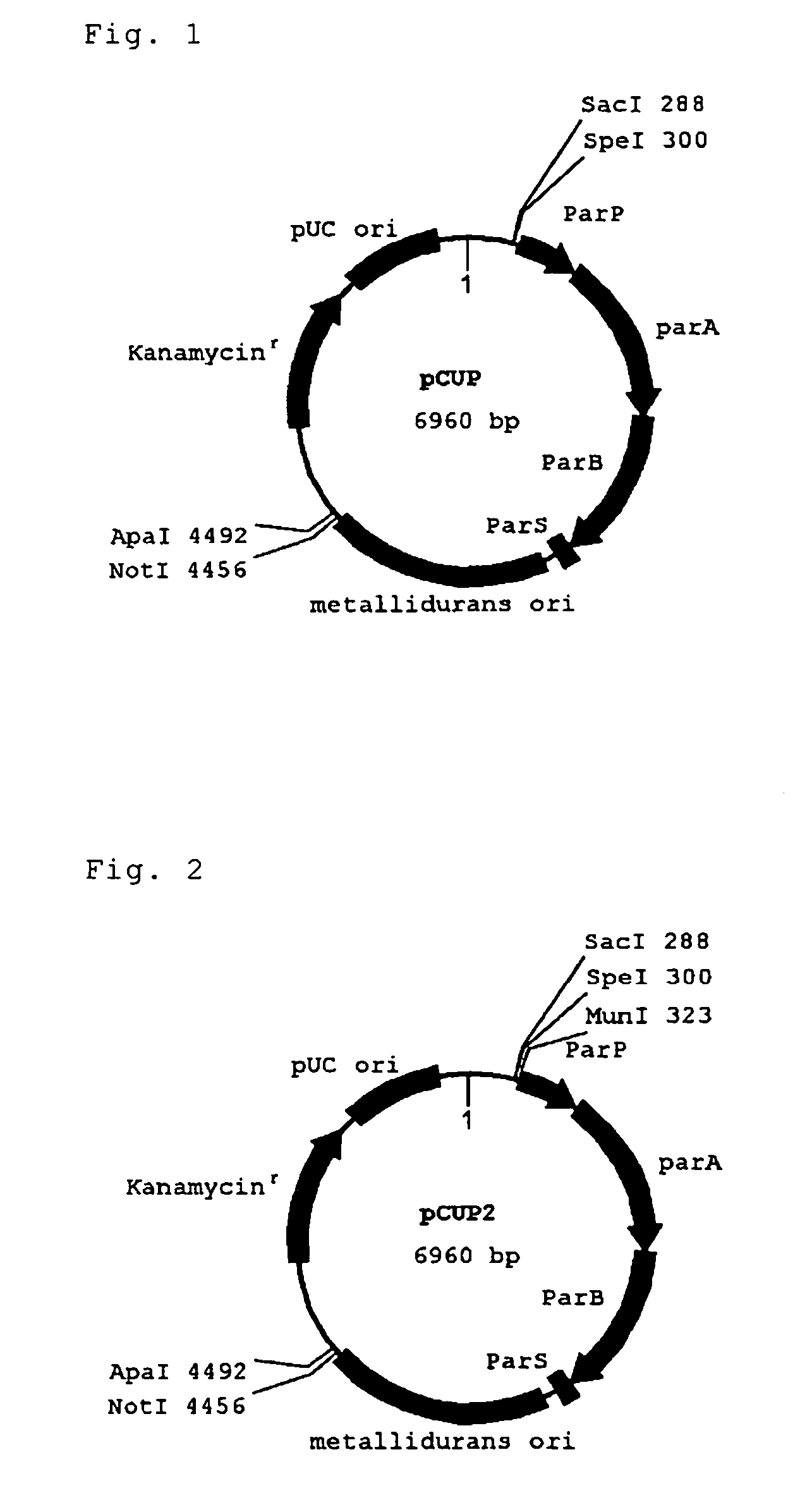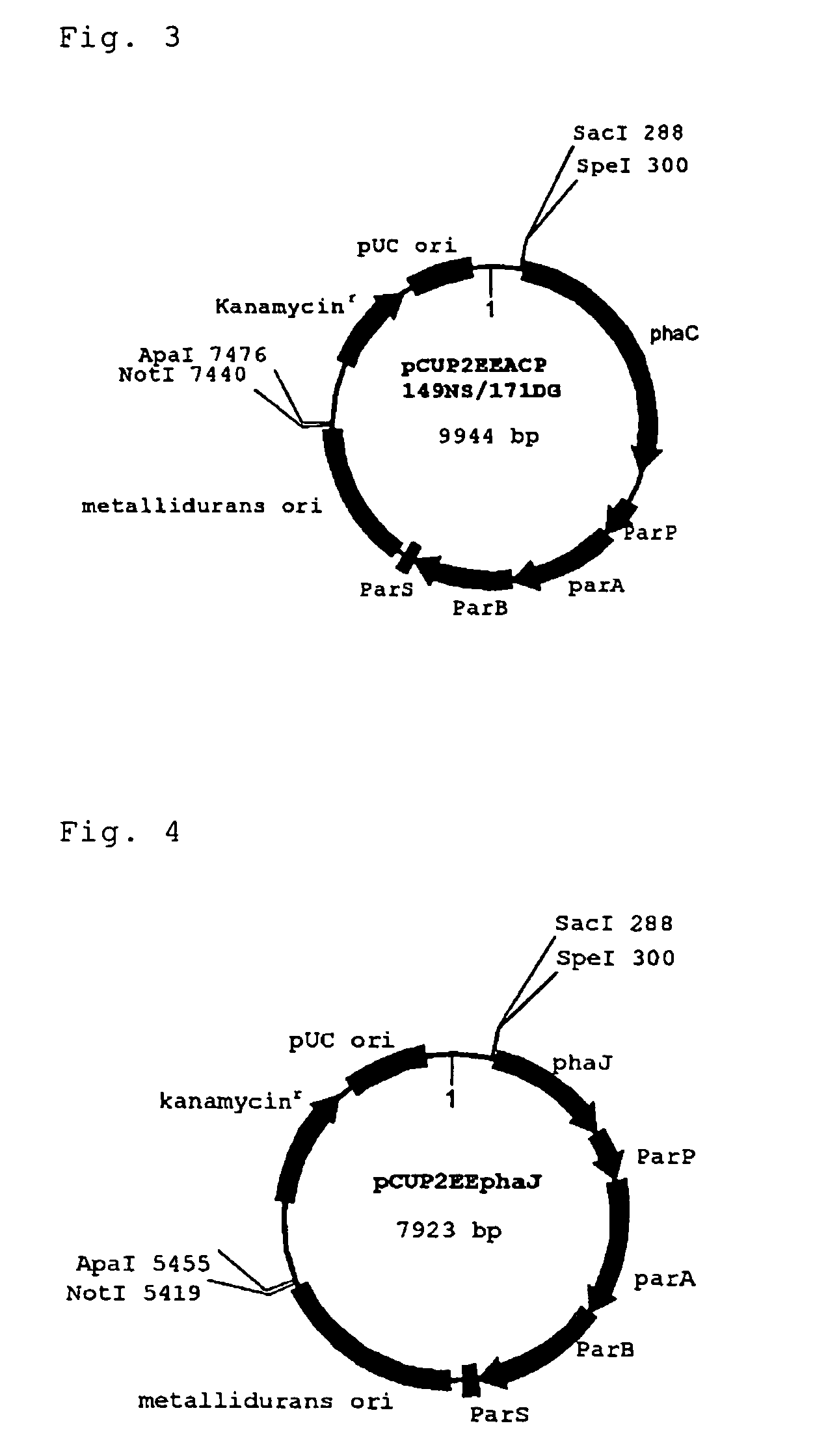Plasmid vector and transformant stably retaining plasmid
a technology of transformant and plasmid, which is applied in the field of vectors, can solve the problems of instability of recombinant plasmid, introduction of instability of gene, and unstable plasmid vectors, and achieve the effect of stabilizing productivity
- Summary
- Abstract
- Description
- Claims
- Application Information
AI Technical Summary
Benefits of technology
Problems solved by technology
Method used
Image
Examples
example 1
Construction of Plasmid Vector pCUP
[0060]The plasmid vector for the introduction of an origin of replication and the par region thereinto in this example is not particularly restricted but may be any one capable of being used in bacteria of the genus Ralstonia. In the plasmid vector constructed in this example, the origin of replication (SEQ ID NO:7) and the par region given under SEQ ID NO:8 of the megaplasmid (pMOL28) retained by the Cupriavidus metallidurans CH34 strain were used. As for the specific construction procedure, a megaplasmid-containing DNA fraction was first prepared from the Cupriavidus metallidurans CH34 strain using a DNA purification kit (product of Promega) and, using this DNA fraction as a template and the primers shown under SEQ ID NO:1 and SEQ ID NO:2, a DNA region (about 4 kbp in size) comprising the sequences shown under SEQ ID NO:7 and SEQ ID NO:8 was amplified by the PCR technique. The PCR conditions were: (1) 2 minutes at 98° C.; (2) 30 seconds at 98° C....
example 2
Construction of Plasmid Vector pCUP2
[0062]For facilitating gene transfer using the plasmid vector of the invention, a restriction enzyme MunI site was further introduced into pCUP obtained in Example 1. As for the specific construction procedure, the PCR was carried out by the PCR technique using pCUP constructed in Example 1 as a template and the primers shown under SEQ ID NO:5 and SEQ ID NO:6, followed by ligation of the amplified fragment using a DNA ligase (Ligation High (product of Toyobo Co.)), whereby pCUP2 shown in FIG. 2 was constructed with a MunI introduced therein. The PCR conditions were: (1) 2 minutes at 98° C.; (2) 30 seconds at 98° C., (3) 30 seconds at 55° C. and (4) 5 minutes at 72° C., 30 cycles from (2) to (4). The polymerase used was TaKaRa Pyrobest DNA Polymerase (product of Takara Bio Inc.).
[0063]Thus was constructed a plasmid vector containing the DNA region identified under SEQ ID NO:18 and the DNA region identified under SEQ ID NO:19 and free of such genes ...
example 3
Transformant Production Using Plasmid Vector pCUP2
[0064]The transformation was carried out by the electroporation technique in the following manner. The gene transfer apparatus used for electroporation was the Gene Pulser produced by Bio-Rad Laboratories, Inc., and the cuvette used was BioRad's one with a gap of 0.2 cm. Competent cells (400 μl) of the Ralstonia eutropha H16 strain and 5 μl of a plasmid pCUP2 solution prepared were poured into the cuvette, which was then set in the pulser. Electric pulses were applied under the following conditions: electrostatic capacity 25 μF, voltage 1.5 kV, resistance value 800Ω. After pulse application, the bacterial suspension in the cuvette was subjected to 3 hours of shake culture in a nutrient broth medium (product of DIFCO Laboratories) at 30° C., followed by 2 days of cultivation on selective plates (nutrient agar medium (product of DIFCO Laboratories), 100 mg / L of kanamycin) at 30° C., to give a transformant strain.
PUM
| Property | Measurement | Unit |
|---|---|---|
| temperature | aaaaa | aaaaa |
| voltage | aaaaa | aaaaa |
| resistance | aaaaa | aaaaa |
Abstract
Description
Claims
Application Information
 Login to View More
Login to View More - R&D
- Intellectual Property
- Life Sciences
- Materials
- Tech Scout
- Unparalleled Data Quality
- Higher Quality Content
- 60% Fewer Hallucinations
Browse by: Latest US Patents, China's latest patents, Technical Efficacy Thesaurus, Application Domain, Technology Topic, Popular Technical Reports.
© 2025 PatSnap. All rights reserved.Legal|Privacy policy|Modern Slavery Act Transparency Statement|Sitemap|About US| Contact US: help@patsnap.com



